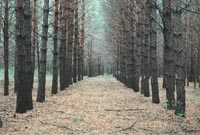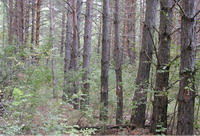|
Полный текст html
Полный текст pdf
"Хвойные бореальной зоны" 2009г., №1, с.
110-111
БИОРАЗНООБРАЗИЕ МАКРОМИЦЕТОВ РОДА ARMILLARIA И ИХ РОЛЬ В БОРЕАЛЬНЫХ ЛЕСАХ МОСКОВСКОГО РЕГИОНА (РОССИЯ)
Селочник Н.Н.
Институт леса им. В.Н.Сукачева СО РАН
660036 Красноярск, Академгородок, 50
Исследование биоразнообразия видов комплекса Armillariaвелось в России в конце 1980-х и спустя 15 лет нами (2003-2008 гг.) в совместных проектах с институтом дендрологии Польской АН и лесным научно-исследовательским институтом Финской АН. С помощью генетического теста идентифицировано 4 вида в разных местообитаниях европейской России, в том числе 3 из них (A.borealis, A. cepistipes, A. ostoyae) в нарушенных бореальных лесах Московского региона и прилегающих областей. Изучены распространенность и свойства этих видов.
Ключевые слова: Armillaria, патогены, сапротрофы, генетический тест, растение-хозяин, генерация
Studies of species diversity of Armillaria complex were conducted in Russia at the end of 1980-s. and after 15 years ( 2003-2008) by us jointly with Polish and Finnish investigators using mating test. Four species was identified in different locations of European Russia, three from them (A. borealis, A. cepistipes, A. ostoyae) were revealed in disturbed boreal forests of Moscow, Vladimir, and A. borealis in Kaluga provinces. Spreading and some properties of these species were noted.
Keywords: Armillaria, pathogens, saprotrophs, genetic test, plant-host, generation
Библиографический список
Бурова, Л.Г. Данные по экологии опенка настоящего Armillariellamellea (Fr.) Karst. в лесах Подмосковья / Л.Г. Бурова // Экология. – 1983.–№ 4.– С.65-68.
Павлов, И.Н. Морфологические признаки грибов комплекса Armillariasensu latoциркумбореальной зоны / И.Н. Павлов, А.Г. Миронов, Н.Р. Кутафьева // Хвойные бореальной зоны. – 2006. – № 3. – С. 14-21.
Радзиевская, М.Г. Структура комплекса Armillariasensulato. автореф. дисс…канд. биол. наук: 03.00.24 –Микология / М.Г. Радзиевская. – Москва, 1989. –23 с.
Федоров, Н.И. Вредоносность видов Armillariaв лесных культурах хвойных пород /Н.И. Федоров, В.Б. Звягинцев // Леса Европейского региона – устойчивое управление и развитие. Междунар. научно-практич. конф., Минск, 4-6 декабря 2002. - Минск, 2002.– Ч. 2.– С. 124-127.
Andersen, J.B. Relashionships between European and North American biological species of Armillaria mellea in North America / J.B. Andersen, K. Korhonen, R.C. Ulrich // Mycologia. –1980.–V.71.– No. 2. – P. 402-414.
Filip, G. First report of Armillariaostoyae on Pinus koraiensis in the Russian Far East / Filip G., MacDonald G.,Sapozhnikov A., Harberger // Plant Disease. –1993.–V. 77.– P. 101. (Abstr.).
Korhonen, K. Interfertility and clonal size in the Armillaria mellea complex / K. Korhonen // Karstenia. – 1978. –V.18.– P.31-42.
Korhonen, K. Fungi belonging to the genera Heterobasidion and Armillaria in Eurasia / K. Korhonen // Fungal Communities in Forest Ecosystems. Materials of Coordination Investigations, Vol. 2. Storozhenko VG, Krutov VI (ed.): Institut Lesovedeniya RAN, Institut lesa Karel'skogo NTs RAN. – Moscow – Petrozavodsk. – 2004. – P. 89-113.
Selochnik, N. The Armillaria species identified with the aid of mating tests in Russia / N. Selochnik, K. Korhonen // Proc. of the 12th IUFRO Intern. conf. "Root and butt rots of forest trees". Berkeley – California, Medford – Oregon, Aug. 12-19, 2007. –The University of California, Berkeley, USA.– 2008. – P. 11-14.
Selochnik, N. Armillaria spp. in some regions of Russia / N. Selochnik, K. Przybyl, K. Ufnalsky // Proc. of the 11th IUFRO Intern. Conf. "Root and butt rots of forest trees". – Poznan and Bialowieza.– Poland.– Aug. 16-22, 2004.–Poznan. – 2005.– P. 42- 46. |




